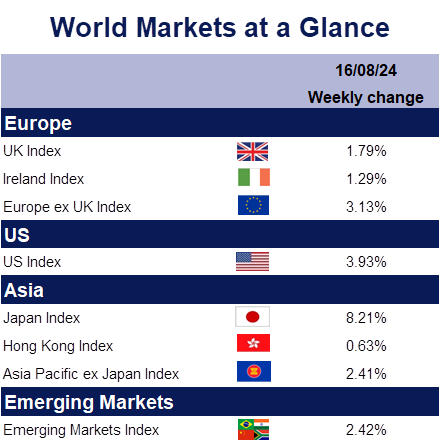The latest figures reassured investors that inflation is continuing its descent, sparking speculation that the Federal Reserve’s cautious approach is working and that it may soon pivot towards cutting interest rates, especially in light of recent indicators of a cooling labour market.
The strength of the American consumer continues to defy expectations. Retail sales surged by 1% in July, a sharp rebound from June’s 0.2% decline and above forecasts. This unexpected boost in consumer spending suggests that, despite a softening labour market, household spending remains robust. There were more positive signals from the US, as consumer sentiment also showed signs of improvement. The University of Michigan’s Consumer Sentiment Index rose for the first time in six months, hitting 67.8 in August—a welcome sign that consumer confidence may be stabilising.
Across the Atlantic, the UK economy showed modest growth in the second quarter of 2024, with GDP rising by 0.6%, marking a slight slowdown from the previous quarter’s 0.7% growth. While the economy remained resilient, the data revealed no growth in June, aligning with expectations. Heavy rain led to weaker retail sales and a doctor’s strike contributed to a drop in healthcare activity. While growth is steady, momentum may be waning, leaving the door open for the Bank of England to potentially loosen policy further.
In Asia, China’s economic data was mixed. Retail sales in July exceeded expectations with a 2.7% increase, signalling strong consumer demand. However, industrial production lagged slightly, growing by 5.1% compared to the forecasted 5.2%, reflecting ongoing challenges in the manufacturing sector.
Japan, on the other hand, delivered a strong performance with 0.5% quarter-over-quarter GDP growth in Q2. This robust economic performance was overshadowed by political uncertainty, as Prime Minister Fumio Kishida announced he would not seek re-election as leader of the ruling Liberal Democratic Party, citing the need for a “new start.” His approval ratings had plunged to 15.5% last month, the lowest for a Japanese prime minister in over a decade. Recent market and currency volatility, combined with uncertainty surrounding inflation and interest rates, has led us to reduce our exposure to the region, shifting from a neutral to an underweight position.
Coming up next week are China’s interest rate decisions, Eurozone inflation data, and the Federal Reserve minutes from their last meeting. Additionally, PMI data for the US, UK, and Eurozone, as well as UK consumer confidence, will be closely watched. Investors will also be paying attention to the Jackson Hole Symposium (August 22-24), where Fed Chair Jerome Powell may provide some forward guidance on the path of interest rates.
Kate Mimnagh, Portfolio Economist



